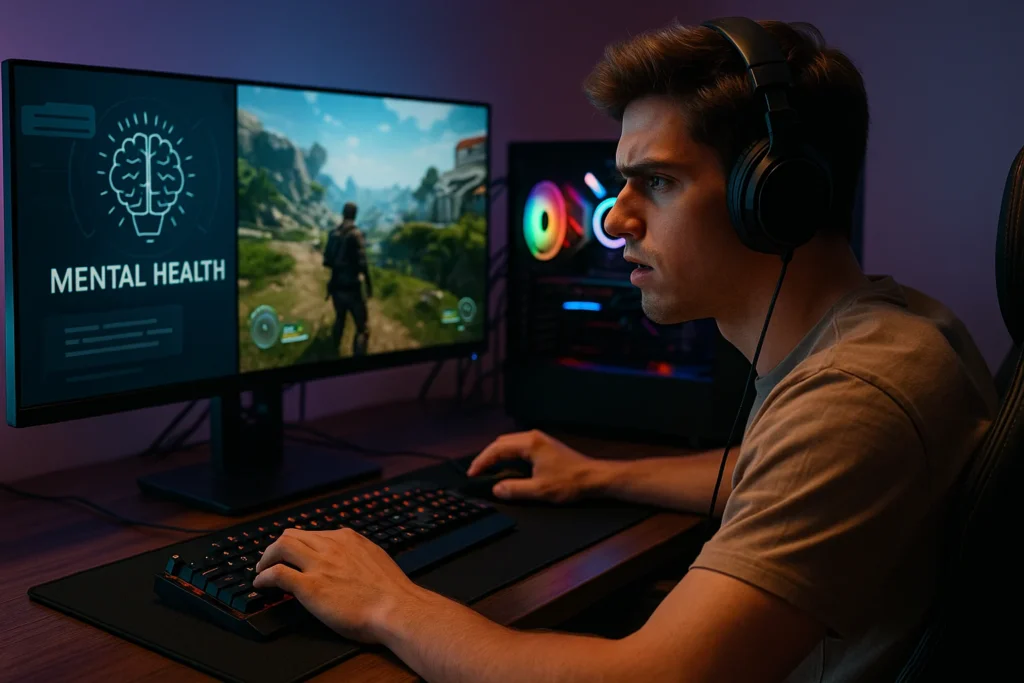Introduction: The Shifting Playfield
Remember when video games were just about pushing buttons and racking up points? In 2025, that simple idea has transformed into something far more complex and captivating. Gaming is no longer just a hobby; it’s a massive industry grappling with incredible new possibilities and significant challenges. We’re talking about hyper-realistic virtual worlds that feel like a second home, characters that seem to understand your emotions, and new ways to spend (or earn) money within games.
But with this amazing growth comes a new reality. The industry is now balancing the excitement of the metaverse with growing concerns about mental health, trying to find fair ways to make money, and facing more rules from governments. This article will explore these major shifts in the gaming world of 2025, from how games are built to how they’re played, and what it all means for players, parents, and the future of entertainment.
More Than Just Code: The Rise of Emotionally Intelligent NPCs
Imagine a game character who doesn’t just follow a script but actually seems to understand your mood, remembers your choices, and reacts in a way that feels genuinely human. In 2025, thanks to advancements in artificial intelligence (AI), this is becoming a reality with emotionally intelligent NPCs (Non-Player Characters).
Companions and Confidantes
AI is no longer just about making enemies smarter or allies more capable in battle. Now, developers are using AI to create NPCs that can:
- Understand Context: They can pick up on hints in your dialogue or actions, responding in ways that feel personalized. For example, a village elder in a fantasy game might offer more comforting words if your character seems down, or a merchant might offer a better deal if you’ve previously shown them kindness.
- Form “Relationships”: While not true consciousness, these NPCs can simulate deeper bonds. A companion character might remember a past adventure you shared, or express concern if your character is injured. This fosters a stronger sense of connection and immersion for the player.
- Impact on Engagement: This next level of AI makes game worlds feel incredibly alive and responsive. Players spend more time immersed, forming parasocial relationships with these digital beings, and feeling a stronger emotional tie to the game’s story and characters. It pushes the boundaries of storytelling, making players feel truly seen and heard within the virtual world.
However, this also brings up new questions about how deeply players can get emotionally attached to these AI creations and the potential for emotional manipulation, as game designers gain more power to influence player feelings.
Beyond the Loot Box: Reshaping Monetization
For years, many games relied on “loot boxes”—mystery digital items that players would pay real money for, without knowing what they’d get. This often felt like gambling, especially to younger players, and led to a lot of controversy. In 2025, the way games make money is undergoing a major transformation.
Fairer Play, New Models
- Government Crackdowns: Governments worldwide are cracking down on predatory microtransactions. Belgium was an early adopter with its outright ban on loot boxes, and other countries like the Netherlands and parts of the United States are actively debating or implementing stricter regulations. The focus is moving beyond just loot boxes to scrutinize other forms of microtransactions that might be deemed exploitative, especially when targeting children.
- Transparency is Key: The industry is being pushed towards greater transparency. This means clearly showing the odds of getting certain items, or moving towards battle passes and cosmetic-only stores where players know exactly what they’re paying for.
- Subscription Services and Battle Passes: Many game companies are shifting towards models like subscription services (think Xbox Game Pass or PlayStation Plus) that offer a vast library of games for a monthly fee. Battle passes, where players pay a flat fee to unlock a tier of cosmetic rewards as they play, have also become a popular and generally more accepted monetization model.
- Creator Economies in the Metaverse: In the emerging metaverse, new monetization models are appearing, focused on user-generated content. Players can create and sell their own virtual items, experiences, or even land, fostering a digital economy where creativity can be directly rewarded.
This shift isn’t just about avoiding fines; it’s about building long-term trust with players by creating fairer, more predictable ways to pay for content.
Balancing Play and Well-being: Health Guidelines and Gaming
As gaming has become a central part of many lives, especially for teenagers, global health organizations are stepping up to provide guidance on balanced play and its connection to mental health. In 2025, there’s a clearer understanding that while gaming can be beneficial, excessive play can have negative impacts.
WHO and the Conversation Around Screen Time
- Gaming Disorder Guidelines: The World Health Organization (WHO) formally recognized “Gaming Disorder” (GD) in its International Classification of Diseases (ICD-11), which became effective in 2022. This classification signifies a global acknowledgment that problematic gaming behavior, characterized by impaired control and increasing priority given to gaming, can lead to significant distress or impairment.
- Updated Screen Time Guidelines: Following the WHO’s lead, health organizations and public health bodies worldwide are issuing updated guidelines on gaming and teen mental health. These guidelines emphasize the importance of balanced screen time, encouraging parents and educators to promote diverse activities beyond gaming. They often recommend setting clear limits, fostering open communication, and recognizing signs of problematic gaming.
- Focus on Well-being: The conversation isn’t just about limiting gaming, but about promoting healthy gaming habits. This includes encouraging social interaction within games, recognizing the cognitive benefits (problem-solving, hand-eye coordination), and using games as a tool for relaxation when balanced with other activities.
This increased focus from health organizations is pushing both parents and the gaming industry to think more critically about how games impact young minds and ensure a healthier gaming ecosystem.
Two Paths Converge? VR Immersion vs. Lo-Fi Nostalgia
The gaming world in 2025 is experiencing an interesting split in trends, like two different roads appealing to different types of travelers. On one side, there’s the push for ultra-realistic, deeply immersive experiences, while on the other, a love for simpler, more charming games is thriving.
The Great Divide in Digital Play
- Hyper-Immersive VR: The dream of stepping directly into a game world is closer than ever. Hyper-immersive VR (Virtual Reality) and AR (Augmented Reality) technologies are gaining momentum, offering unprecedented levels of presence and interaction. These experiences, often tied to the evolving metaverse, promise vast virtual worlds where players can work, socialize, and play in ways that blur the lines between digital and physical reality.
- Nostalgic 2D/Lo-Fi Indie Games: But while some are chasing realism, a strong counter-movement celebrates simplicity. Nostalgic 2D/lo-fi indie games are enjoying a surge in popularity. These games often feature pixel art, retro graphics, and straightforward mechanics. They appeal to players looking for unique artistic experiences, compelling storytelling, or a return to the simpler joys of gaming without the pressure of cutting-edge graphics or complex interfaces. Think of games that evoke the charm of 8-bit or 16-bit eras, offering a cozy and often more relaxing experience.
This split shows that the gaming audience is diverse. Some crave the next big leap in technology, while others find joy and connection in the artistry and accessibility of simpler, more heartfelt creations.
Beyond the Game: Esports, Education, and Therapy
The influence of gaming is now extending far beyond entertainment, touching critical areas like mental well-being in professional competition and transforming learning and therapeutic practices.
Gaming for Good
- Esports Mental Health: As esports continues to grow into a multi-billion dollar industry, the pressure on professional players is immense. Long hours of practice, intense competition, and public scrutiny can take a heavy toll. In 2025, esports mental health coaching is becoming standard practice. Top teams and organizations are recognizing the importance of providing psychologists, performance coaches, and therapists to help players manage stress, anxiety, burnout, and maintain peak performance. This holistic approach treats esports athletes like traditional athletes, acknowledging the mental rigor required.
- Gamified Learning: The idea of learning through play is nothing new, but gamified learning is reaching new heights. Educational platforms and apps are integrating game mechanics – points, badges, leaderboards, narrative progression – to make learning more engaging and effective. From mastering a new language to understanding complex scientific concepts, games are transforming education into an interactive adventure.
- Virtual Exposure Therapy: In the medical field, virtual exposure therapy is gaining ground. VR environments are used to treat phobias, PTSD, and anxiety by safely exposing patients to triggers in a controlled, immersive setting. For example, someone with a fear of heights can gradually confront it in a virtual skyscraper, helping them manage their anxiety in a safe space.
- Mindfulness Games: A growing genre of mindfulness games is also emerging. These are designed not for high scores, but for relaxation, focus, and emotional regulation. Think of games that involve calming puzzles, serene exploration, or guided meditation within a digital world, offering a unique tool for mental well-being.
These crossovers highlight gaming’s versatile nature, proving it can be a powerful tool for personal growth, healing, and skill development, not just leisure.
Conclusion: Playing Our Way Forward
The gaming landscape in 2025 is a vibrant, evolving ecosystem, brimming with incredible technological advancements and a growing awareness of its impact on players. We’ve seen the rise of emotionally intelligent NPCs that blur the lines between code and companionship, fundamentally changing how we engage with virtual worlds. The industry is actively grappling with monetization models, moving away from predatory practices like loot boxes towards more transparent and player-friendly approaches, often spurred by governments cracking down on microtransactions.
Health organizations, including the WHO, are providing vital guidelines on gaming and teen mental health, pushing for a balanced approach to screen time and addressing the challenges of potential addiction. Meanwhile, the very nature of play is diversifying, with a distinct split between hyper-immersive VR experiences that promise metaverse frontiers and the comforting charm of nostalgic 2D/lo-fi indie games. Beyond entertainment, gaming’s positive influence is expanding, with esports mental health coaching becoming standard, and innovative crossovers with education and therapy demonstrating gaming’s potential for learning and healing.
Ultimately, gaming in 2025 is more than just entertainment; it’s a reflection of our technological prowess, our evolving understanding of well-being, and our constant search for connection and meaning. As the digital playfield continues to expand, the industry faces the exciting challenge of harnessing its power responsibly, ensuring that the new reality of gaming is one that enriches lives, supports mental health, and creates truly meaningful experiences for everyone.



